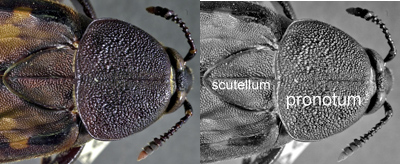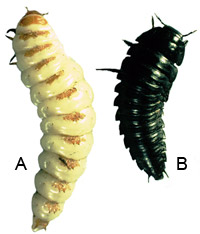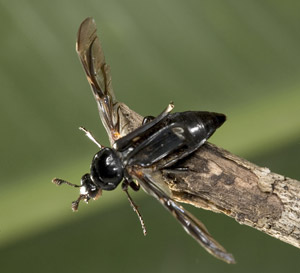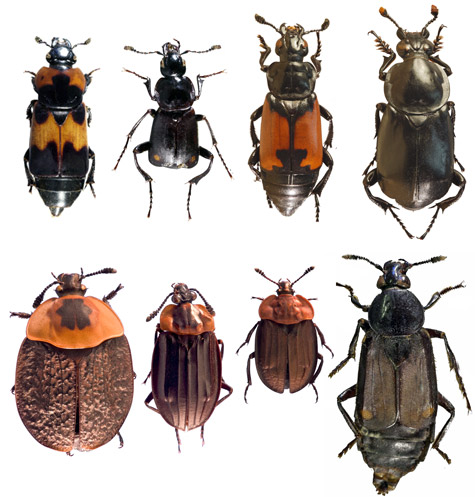Silphidae
Large carrion and burying beetles
Derek S. Sikes, Stephen T. Trumbo, and Stewart B. Peck


This tree diagram shows the relationships between several groups of organisms.
The root of the current tree connects the organisms featured in this tree to their containing group and the rest of the Tree of Life. The basal branching point in the tree represents the ancestor of the other groups in the tree. This ancestor diversified over time into several descendent subgroups, which are represented as internal nodes and terminal taxa to the right.

You can click on the root to travel down the Tree of Life all the way to the root of all Life, and you can click on the names of descendent subgroups to travel up the Tree of Life all the way to individual species.
For more information on ToL tree formatting, please see Interpreting the Tree or Classification. To learn more about phylogenetic trees, please visit our Phylogenetic Biology pages.
close boxWell supported basal split dividing the family into two subfamilies.
Introduction
The Silphidae are among the largest and most conspicuous of the staphylinoid beetles. Most species are carrion-associated and will breed at carrion on which the larvae will feed. Adults of some (most?) species will opportunistically prey on fly larvae, and various species have been found at both dung and certain fungi.
There are two distinct lineages or clades of silphids currently ranked as subfamilies. The Silphinae typically breed at large carcasses and show little to no parental care whereas the Nicrophorinae, in particular the genus Nicrophorus, show the opposite pattern. They breed at small carcasses (<300g, usually <50g) which a pair of parents will bury into a subterranean crypt in which to rear their brood. Members of the genus Nicrophorus are unusual among the Coleoptera in showing biparental care of their offspring. Some species have been found to breed communally on carcasses too large to bury.
There is a relatively extensive literature on silphid biology, although primarily focused on the more behaviorally complex species of the Nicrophorinae, much of which has been reviewed by Anderson and Peck (1985), Ratcliffe (1996), Eggert and Müller (1997) and Scott (1998). Heymons published a series of classic works describing the biology of various European silphine species (Heymons et al. 1926, 1927, 1928, 1929, 1930a, 1930b; Heymons & Lengerken 1931, 1932a, 1933b, 1934). The life history of Necrodes surinamensis was described by Ratcliffe (1972) but few other silphine species have been studied in detail. See Sikes (in press) for more detailed information on silphid biology, morphology, and phylogeny.
Characteristics
Hansen (1997) listed 13 possible synapomorphies of the Silphidae:
- Subapical bulge on each elytron
- Relatively large clypeus
- Mandibles without a mola
- Antennal insertions on dorsal face of head
- Cupuliform segment 8 of antenna
- Antenna with well defined, densely pubescent, 3 segmented club
- Abdominal segment 9 and 10 everted
- Abdominal terga 1-3 weakly sclerotized
- Abdominal sternum 2 well demarcated and visible
- Noncarinate basal ventrite
- Inflexed portion of abdominal sterna demarcated but not articulated to ventral portion
- Gonocoxites relatively short and flat
- Larval galea present as a small (fixed) appendage on lacinia
Silphids are dorso-ventrally flattened beetles and are among the largest-bodied of the staphylinoids, typically ranging in length from 12-20 mm. Their antennae are eleven segmented, however, species in the subfamily Nicrophorinae have a greatly reduced pedicel (antennomere 2) that is fused to the scape (antennomere 1) making them appear to have a 10 segmented antenna. Species in the subfamily Silphinae lack a frontoclypeal (epistomal) suture. Species in the subfamily Nicrophorinae bear a pair of stridulatory files on the 5th abdominal tergite (just under the apex of the elytra). The scutellum of silphids is very large, sometimes as wide as the head:


Dorsal view of the head and thorax of Diamesus showing the large scutellum. Image copyright © 2005 Derek S. Sikes.
The larvae differ between the subfamilies with silphine larvae bearing a cluster of 6 stemmata (ocelli) on each side of the head and nicrophorine larvae bearing only a single stemma on each side. In addition, the larvae of the Silphinae are strongly and widely sclerotized whereas the larvae of the Nicrophorinae (particularly Nicrophorus) are weakly and sparsely sclerotized:


Larvae of A) Nicrophorus sp. and B) Silphinae gen. sp.. Image copyright © 2005 Derek S. Sikes.
Discussion of Phylogenetic Relationships
Dobler and Müller (2000) used sequences of the genes COI and COII to infer the phylogenetic relationships for 11 genera of the Silphinae and 2 of the Nicrophorinae. Their results strongly supported the monophyly of two main clades in the Silphidae that correspond to the subfamilies Silphinae and Nicrophorinae and most included genera with the exception of Silpha (which was recovered as paraphyletic with respect to Aclypea).
Silphid Monophyly
The Silphidae, as currently defined with only two subfamilies (Lawrence & Newton 1982), has been considered "undoubtedly monophyletic" (Hansen 1997). However, we cannot consider the monophyly of the Silphidae to be adequately tested at this point because we do not yet know what group is the sister lineage to the silphids. Hatch (1927) classified the silphids as a subfamily of the Staphylinidae near the Omaliinae but his classification did not gain acceptance. More recent works place silphids very close to, or tentatively inside the Staphylinidae (e.g. Lawrence & Netwon 1982; Lawrence 1982, Hansen 1997, Caterino et al. 2005) but many hypotheses remain unsatisfactorily tested. The consensus literature treats the group as a distinct family in a similar manner to the earlier classification of the tiger beetles as a family (Cicindelidae) that are now placed as a subgroup (Cicindelitae) within the ground beetles (Carabidae).
All but the first of Hansen's proposed silphid synapomorphies (see Characteristics) are convergent with one or more of the staphyliniform ingroup taxa in his study; leaving only one unique character state supporting the monophyly of the Silphidae (subapical bulge on each elytron).
Beutel and Molenda (1997) analyzed larval characters and found 3 of the 33 characters in their analysis to be derived (apomorphic) for the Silphidae, but none were uniquely so. There are a number of potential characters that have not been fully investigated which could prove to be synapomorphies of the Silphidae such as the pair of eggbursters on the hypopharynx of silphid first instars and the position in which adults hold their elytra during flight.


Nicrophorus kieticus about to fly showing position that the elytra are held during flight. Image copyright © 2005 Derek S. Sikes.
References
Anderson, R. S. & Peck, S. B. 1985. The Carrion Beetles of Canada and Alaska (Coleoptera: Silphidae and Agyrtidae). The Insects and Arachnids of Canada, Part 13. Publication 1778, Research Branch Agriculture Canada, Ottawa. 121 pp.
Beutel, R. G. & Molenda, R. 1997. Comparative morphology of selected larvae of Staphylinoides (Coleoptera, Polyphaga) with phylogenetic implications. Zoologischer Anzeiger, 236: 37-67.
Caterino, M. S., T. Hunt, & A. P. Vogler. 2005. On the constitution and phylogeny of Staphyliniformia (Insecta: Coleoptera). Molecular Phylogenetics and Evolution 34: 655-672.
Dobler, S. & Müller, J. K. 2000. Resolving phylogeny at the family level by Mitochondrial Cytochrome Oxidase sequences: Phylogeny of carrion beetles (Coleoptera: Silphidae). Molecular Phylogenetics and Evolution 15(3): 390-402.
Eggert, A. -K. & J. K. Müller. 1997. Biparental care and social evolution in burying beetles: Lessons from the larder. pp. 216-236 in Social Behavior in Insects and Arachnids (J. C. Choe, B. J. Crespi, eds.) Cambridge University Press, Cambridge, New York & Oakleigh: v-xiii, 1-541.
Hansen, M. (1997): Phylogeny and classification of the staphyliniform beetles families (Coleoptera) Biologiske Skrifter 48: 1-339.
Heymons, R., H. von Lengerken, & M. Bayer. 1926. Studien über die Lebenserscheinungen der Silphini (Coleopt.). I. Silpha obscura L. Zeitschrift für Morphologie und Ökologie der Tiere 6: 287-332.
Heymons, R., H. von Lengerken, & M. Bayer. 1927. Studien über die Lebenserscheinungen der Silphini (Coleopt.). II. Phosphuga atrata L. Zeitschrift für Morphologie und Ökologie der Tiere 9: 271-312.
Heymons, R., H. von Lengerken, & M. Bayer. 1928. Studien über die Lebenserscheinungen der Silphini (Coleopt.). III. Xylodrepa quadripunctata L. Zeitschrift für Morphologie und Ökologie der Tiere 10: 330-352.
Heymons, R., H. von Lengerken, & M. Bayer. 1929. Studien über die Lebenserscheinungen der Silphini (Coleopt). IV. Blitophaga opaca L. (Glattstreifiger Rübenaaskäfer). Zeitschrift für Morphologie und Ökologie der Tiere 14: 234-260.
Heymons, R., H. von Lengerken, & M. Bayer. 1930a. Studien über die Lebenserscheinungen der Silphini (Coleopt.). V. Silpha tyrolensis Laich. Zeitschrift für Morphologie und Ökologie der Tiere 17: 262-274.
Heymons, R., H. von Lengerken, & M. Bayer. 1930b. Studien über die Lebenserscheinungen der Silphini (Coleopt). VI. Blitophaga undata Müll. (Buckelstreifiger Rübenaaskäfer). Zeitschrift für Morphologie und Ökologie der Tiere 18: 170-188.
Heymons, R., & H. von Lengerken. 1931. Studien über die Lebenserscheinungen der Silphini (Coleopt). VII. Oiceoptoma thoracica L. Zeitschrift für Morphologie und Ökologie der Tiere 20: 691-706.
Heymons, R., & H. von Lengerken. 1932a. Studien über die Lebenserscheinungen der Silphini (Coleopt). VIII. Ablattaria laevigata F. Zeitschrift für Morphologie und Ökologie der Tiere 24: 259-287.
Heymons, R., & H. von Lengerken. 1932b. Studien über die Lebenserscheinungen der Silphini (Coleopt). IX. Silpha carinata L. Zeitschrift für Morphologie und Ökologie der Tiere 25: 534-548.
Heymons, R., & H. von Lengerken. 1934. Studien über die Lebenserscheinungen der Silphini (Coleopt). X. Silpha tristis Illig. Zeitschrift für Morphologie und Ökologie der Tiere 28: 469-479.
Lawrence, J. F. & Newton, A. F., jr. 1982. Evolution and classification of beetles. Annual Review of Ecology and Systematics, 13: 261-290.
Peck, S. B. 2001. Silphidae Latreille, 1807 Pp. 268-271 in: R. H. Arnett and M. C. Thomas (eds). American Beetles: Archostemata, Myxophaga, Adephaga, Polyphaga: Staphyliniformia. Vol.1 Boca Raton: CRC Press. 443 pp.
Ratcliffe, B. C. 1972. The natural history of Necrodes surinamensis (Fabr.) (Coleoptera: Silphidae). Transactions of the American Entomological Society 98: 359-410.
Scott, M. P. 1998. The ecology and behavior of burying beetles. Annual Review of Entomology 43:595-618.
Sikes, D. S. in press. Silphidae. in: Handbook of Zoology, Hexapoda (Kristensen, N. P. & Beutel, R. G. eds.), Coleoptera I (Beutel, R. G. & Leschen, R. A. B. eds.). De Gruyter, Berlin.
Information on the Internet
Nicrophorus Central: A website devoted to research on the subfamily Nicrophorinae.Title Illustrations

| Comments | Four nicrophorines (from left: Ptomascopus zhangla Hava, Schneider, & Ruzicka; Eonecrophorus tenuicornis Kurosawa; Nicrophorus chilensis Philippi; N. concolor Kraatz) and four silphines (bottom row from left: Necrophila americana (L.); Oxelytrum erythrurum (Blanchard); Oiceoptoma subrufum (Lewis); Necrodes surinamensis (Fabricius). |
|---|---|
| Image Use |
 This media file is licensed under the Creative Commons Attribution-NonCommercial-ShareAlike License - Version 3.0. This media file is licensed under the Creative Commons Attribution-NonCommercial-ShareAlike License - Version 3.0.
|
| Copyright |
© 2005 Derek S. Sikes

|
About This Page
The following people contributed to the work on which we have based this web presentation. We thank them all for their advice, corrections, contributions of information, and support. Any errors remaining are our own. Michael Ivie, Ronald Madge, Piotr Naskrecki, Alfred Newton, Jan Ruzicka, Carl Schaefer, Chris Simon, Seizi Suzuki, and David Wagner. Many others, too numerous to list here, helped with specimen collection and museum loans, among other aspects of this research. Thanks go to M. Maruyama for his gift of silphid specimens from Japan, some of which we photographed for the images on these webpages. We thank Katja Schulz for her considerable help with editing and constructing this node of the Tree of Life. This work was funded in part by Grant DEB-9981381 from the National Science Foundation to Stephen Trumbo and Stewart Peck.
Derek S. Sikes

University of Calgary, Canada
Stephen T. Trumbo

University of Connecticut, Waterbury, Connecticut, USA
Stewart B. Peck

Carleton University, Ottawa, Ontario, Canada
Correspondence regarding this page should be directed to Derek S. Sikes at
dsikes@ucalgary.ca
, Stephen T. Trumbo at
stephen.trumbo@uconn.edu
, and Stewart B. Peck at
sbpeck@ccs.carleton.ca
Page copyright © 2005 Derek S. Sikes, Stephen T. Trumbo , and Stewart B. Peck
 Page: Tree of Life
Silphidae . Large carrion and burying beetles.
Authored by
Derek S. Sikes, Stephen T. Trumbo, and Stewart B. Peck.
The TEXT of this page is licensed under the
Creative Commons Attribution-NonCommercial-ShareAlike License - Version 3.0. Note that images and other media
featured on this page are each governed by their own license, and they may or may not be available
for reuse. Click on an image or a media link to access the media data window, which provides the
relevant licensing information. For the general terms and conditions of ToL material reuse and
redistribution, please see the Tree of Life Copyright
Policies.
Page: Tree of Life
Silphidae . Large carrion and burying beetles.
Authored by
Derek S. Sikes, Stephen T. Trumbo, and Stewart B. Peck.
The TEXT of this page is licensed under the
Creative Commons Attribution-NonCommercial-ShareAlike License - Version 3.0. Note that images and other media
featured on this page are each governed by their own license, and they may or may not be available
for reuse. Click on an image or a media link to access the media data window, which provides the
relevant licensing information. For the general terms and conditions of ToL material reuse and
redistribution, please see the Tree of Life Copyright
Policies.
- First online 07 February 2005
Citing this page:
Sikes, Derek S., Stephen T. Trumbo, and Stewart B. Peck. 2005. Silphidae . Large carrion and burying beetles. Version 07 February 2005 (under construction). http://tolweb.org/Silphidae/9620/2005.02.07 in The Tree of Life Web Project, http://tolweb.org/







 Go to quick links
Go to quick search
Go to navigation for this section of the ToL site
Go to detailed links for the ToL site
Go to quick links
Go to quick search
Go to navigation for this section of the ToL site
Go to detailed links for the ToL site